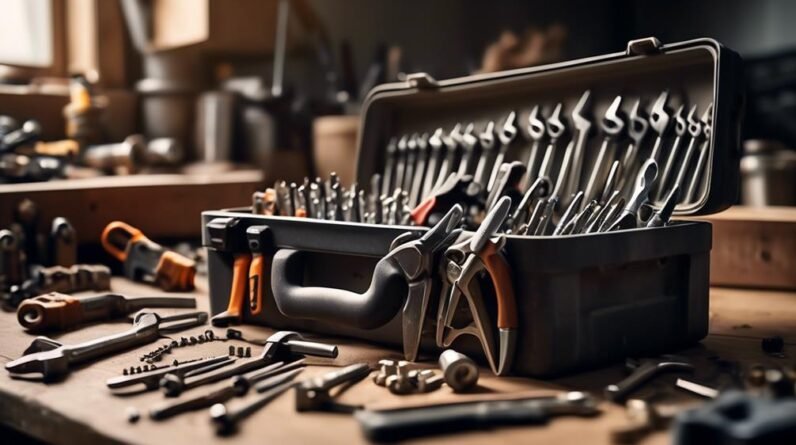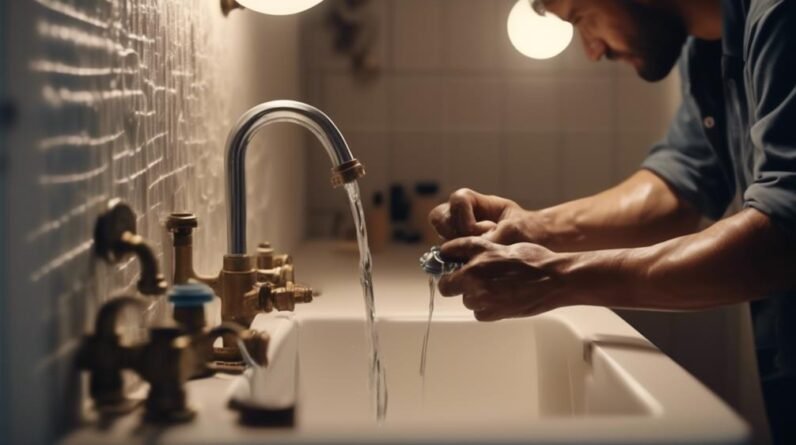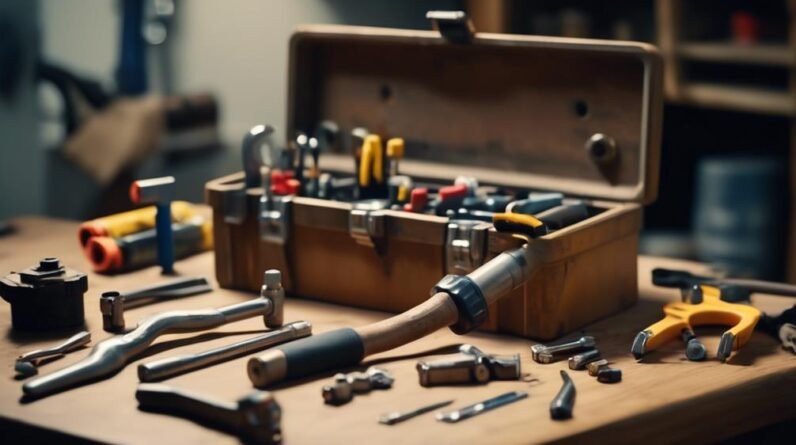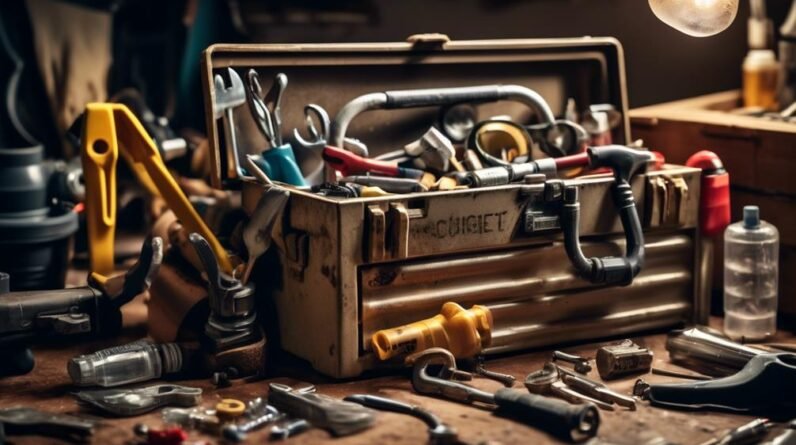
Did you know that the average homeowner spends around 1-4% of their home's value on maintenance and repairs each year? That may not sound like much, but when you consider that the median home price in the United States is $295,000, that adds up to $2,950-$11,800 annually! Fortunately, there are simple home maintenance hacks that can help you save both time and money. From fixing leaky faucets to maintaining HVAC systems, these easy fixes can prevent small problems from turning into costly disasters. So, if you're tired of constantly calling in the professionals for every little issue, keep reading to discover eight simple hacks that will keep your home in tip-top shape.
Key Takeaways
- Regular faucet maintenance can save homeowners money on water bills by fixing leaky faucets caused by worn or damaged valves.
- Baking soda and vinegar can be used as an effective and natural solution for unclogging drains, but persistent clogs may require a drain snake or professional plumber.
- Lubricating hinges with silicone spray or petroleum jelly can silence squeaky doors, and proper maintenance includes cleaning hinge pins and distributing lubricant evenly.
- Spackling is the go-to solution for fixing small holes in walls, and the process involves cleaning the hole, applying spackle, letting it dry, and sanding it for a smooth surface before painting.
Fixing Leaky Faucets
Fixing leaky faucets is a simple and cost-effective home maintenance task that you can easily tackle yourself. Not only will it save you money on water bills, but it will also prevent further damage to your plumbing system. When it comes to fixing toilet leaks, start by checking the flapper valve. This is the rubber piece at the bottom of the tank that seals the water in. If it's worn or damaged, it may need to be replaced. Another common cause of toilet leaks is a faulty fill valve. This is the mechanism that refills the tank after each flush. If you notice water constantly running into the overflow tube, it's likely that the fill valve needs to be adjusted or replaced.
When it comes to repairing showerheads, the most common issue is a clogged or partially blocked nozzle. To fix this, remove the showerhead, soak it in vinegar overnight to dissolve mineral deposits, and then scrub it with a toothbrush to remove any remaining residue. If the showerhead is old or damaged, it may need to be replaced. Remember to use plumber's tape when installing the new showerhead to ensure a tight seal.
Unclogging Drains
To unclog drains effectively, you can try a combination of baking soda and vinegar. This simple DIY solution can help remove stubborn hair clogs and prevent pipe corrosion. Start by pouring half a cup of baking soda down the drain, followed by half a cup of vinegar. The chemical reaction between the two will create a fizzing effect that helps break down the clog. Let it sit for about 30 minutes, then flush the drain with hot water. For more stubborn clogs, you can repeat the process or use a plunger to create pressure and dislodge the blockage. Remember to cover the overflow opening with a wet cloth to ensure proper suction. If the clog persists, you may need to use a drain snake or call a professional plumber. Regularly using a hair strainer in your shower or bathtub can help prevent future clogs by catching hair before it goes down the drain. By following these simple steps, you can keep your drains clear and prevent costly pipe damage.
Silencing Squeaky Doors
Experiencing squeaky doors? Here's a simple solution to silence them quickly and easily. When it comes to door maintenance, lubricating hinges is key. Over time, hinges can become dry and rusty, causing doors to squeak. To fix this, start by gathering some basic supplies: a can of silicone spray lubricant or a tube of petroleum jelly, a clean cloth, and a screwdriver.
First, open the door and locate the hinges. Use the screwdriver to remove the hinge pins one at a time. Wipe off any dirt or debris from the pins and hinges using the cloth. Next, apply a small amount of lubricant to the pins and hinges. Silicone spray lubricant works well for metal hinges, while petroleum jelly is great for plastic or wooden hinges. Be sure to coat the pins and hinges evenly.
Once the lubricant is applied, reinsert the pins and gently tap them back into place using the screwdriver. Open and close the door a few times to distribute the lubricant evenly. If the squeaking persists, repeat the process or consider replacing the hinges. With these simple door maintenance tips, you can silence those squeaky doors and enjoy a quieter home.
Patching Holes in Walls
Ready to tackle those unsightly holes in your walls? Don't worry, patching them up is easier than you think. In this article, we'll discuss some effective wall hole repair techniques and the materials you'll need to get the job done. So let's get started and restore your walls to their former glory.
Wall Hole Repair Techniques
Wondering how to effectively patch holes in your walls? Don't worry, it's easier than you think! When it comes to drywall repair techniques, spackling is your go-to solution for fixing small holes in walls. Start by cleaning the hole and removing any loose debris. Then, apply a thin layer of spackle over the hole using a putty knife, making sure to smooth it out evenly. Let it dry completely, and if needed, apply a second layer for a seamless finish. Once dry, sand the patched area gently to create a smooth surface. Finally, you can paint over the repaired spot to match the rest of your wall. With these simple steps, you can easily fix any small holes in your walls and keep your home looking flawless.
Materials for Patching Holes
To effectively patch holes in your walls, you will need a few key materials. The first essential item is a putty knife, which will help you apply the patching compound smoothly and evenly. Next, you'll need spackling paste or compound, which is specifically designed for drywall repair. This material is easy to work with and dries quickly, making it ideal for small holes and cracks. Additionally, you'll need sandpaper to smooth out the patched area once it's dry. A sanding block or a sanding sponge can be helpful for achieving a smooth finish. Lastly, don't forget to have a damp cloth or sponge handy to clean up any excess compound or dust. With these materials and some basic spackling techniques, you'll be able to patch holes in your walls with ease.
Cleaning and Maintaining Gutters
To keep your gutters in good condition, it's important to regularly clear out any debris that may accumulate. This will help prevent blockages and ensure that rainwater can flow freely. By taking the time to clean and maintain your gutters, you can avoid potential damage to your home's foundation and keep them functioning properly.
Clearing Debris From Gutters
To effectively maintain your gutters, regularly removing debris is essential. Clearing debris from your gutters is crucial in preventing water damage to your home. When leaves, twigs, and other debris accumulate in your gutters, they can clog the system and cause water to overflow. This overflow can lead to water seeping into your home's foundation, causing cracks and other structural issues. To avoid this, make sure to clean your gutters at least twice a year, especially during the fall when leaves are more likely to accumulate. Use a ladder and gloves to remove the debris by hand, or consider using a gutter cleaning tool to make the process easier. By keeping your gutters clear of debris, you'll ensure proper water flow and protect your home from potential water damage.
Preventing Gutter Blockages
Regular maintenance of your gutters is crucial for preventing blockages and ensuring proper water flow. To prevent rust formation and keep your gutters in top shape, here are some simple gutter maintenance tips to follow.
Firstly, make it a habit to clean your gutters at least twice a year, ideally in spring and fall. Remove leaves, twigs, and any other debris that may have accumulated. You can use a ladder and a garden hose to flush out any remaining dirt.
Additionally, consider installing gutter guards or screens to prevent large debris from entering your gutters. These can be easily attached to the top of your gutters and will save you time and effort in the long run.
Lastly, inspect your gutters regularly for any signs of damage or loose screws. Repair or replace any damaged sections promptly to prevent blockages and ensure smooth water flow.
Repairing Cracked Tiles
If you have cracked tiles in your home, there are simple and effective ways to repair them. Don't worry, you don't need to hire a professional for this task. With a little bit of effort and the right materials, you can fix those cracked tiles yourself. Here are four steps to help you repair them:
- Assess the damage: Examine the cracked tile to determine the extent of the damage. If it's just a small chip, you can repair it easily. For larger cracks or multiple cracks, you may need to replace the entire tile.
- Repair chipped ceramics: For small chips, use an epoxy adhesive to fill in the damaged area. Make sure to choose an adhesive that matches the color of your tile. Apply the adhesive to the chip and smooth it out with a putty knife. Let it dry according to the manufacturer's instructions.
- Seal hairline cracks: To seal hairline cracks, use a tile crack repair epoxy. Apply the epoxy to the crack and wipe off any excess with a damp cloth. Let it dry completely.
- Replacing the tile: If the crack is too large or there are multiple cracks, you'll need to replace the tile. Start by removing the damaged tile using a chisel and hammer. Clean the area thoroughly and apply tile adhesive to the back of the new tile. Press it firmly into place and let it dry.
Repairing cracked tiles doesn't have to be a daunting task. With these simple steps, you can restore the beauty of your tiled surfaces and save money on professional repairs.
Preventing Mold and Mildew
Preventing mold and mildew is essential to maintaining the integrity of your home, especially after repairing cracked tiles. These fungi can not only damage your property but also pose health risks to you and your family. To keep your home mold and mildew-free, it's crucial to focus on preventing condensation and controlling humidity levels. Here are some practical tips to help you achieve that:
- Ventilate: Proper ventilation is key to reducing moisture levels in your home. Open windows, use exhaust fans, and install vents in high-moisture areas like the bathroom and kitchen.
- Use dehumidifiers: Dehumidifiers are excellent tools for controlling humidity levels, especially in damp basements or areas prone to moisture buildup.
- Monitor indoor humidity: Invest in a hygrometer to measure the humidity in your home. Ideally, aim for a humidity level between 30% and 50%. If it exceeds 60%, it's time to take action.
By implementing these preventive measures, you can significantly reduce the risk of mold and mildew growth in your home. Remember, a dry and well-ventilated environment is the key to maintaining a healthy and mold-free living space.
| Tip | Description |
|---|---|
| Ventilate | Open windows and use exhaust fans to improve air circulation. |
| Use dehumidifiers | Install dehumidifiers to control humidity levels in damp areas. |
| Monitor humidity | Keep track of indoor humidity levels using a hygrometer. |
Maintaining HVAC Systems
To ensure the optimal functioning of your HVAC system, regular maintenance is essential. Here are some simple tips to help you maintain your air conditioning and furnace:
- Change air filters: Regularly replace your air filters to ensure proper airflow and prevent dirt and debris from clogging the system. This will improve the efficiency of your HVAC system and extend its lifespan.
- Clean the outdoor unit: Remove any debris, leaves, or grass clippings that may have accumulated around the outdoor unit. This will help maintain proper airflow and prevent any potential damage.
- Schedule professional inspections: It's a good idea to have a professional HVAC technician inspect your system at least once a year. They can identify any issues or potential problems and perform necessary maintenance tasks to keep your system running smoothly.
- Keep vents clear: Make sure that your vents are not blocked by furniture, rugs, or other objects. Blocked vents can disrupt airflow and cause your system to work harder, leading to increased energy consumption and potential damage.
Frequently Asked Questions
How Do I Fix a Leaky Faucet if the Problem Persists After Using the Suggested Methods?
If the leaky faucet problem persists despite trying suggested methods, you may need to replace the faucet cartridge or call a professional plumber for further troubleshooting.
What Should I Do if the Drain Is Still Clogged After Trying the Recommended Methods?
If the drain is still clogged after trying the recommended methods, try using a plunger or a drain snake to remove the blockage. To prevent future clogs, regularly clean the drain and avoid putting grease or hair down the drain.
Can I Use WD-40 to Silence a Squeaky Door, or Are There Other Alternatives?
To silence a squeaky door, WD-40 can be used, but there are other alternatives available too. Compare different lubricants to find the best one for your door.
Are There Any Specific Tools or Techniques I Should Use When Patching Larger Holes in Walls?
When patching larger holes in walls, you'll need specific tools like a drywall patch kit, joint compound, and a putty knife. Techniques include applying multiple layers and sanding between coats. Alternative methods for silencing squeaky doors include using graphite powder or soap.
How Often Should I Clean and Maintain My Gutters to Prevent Clogs and Damage?
To prevent clogs and damage, clean and maintain your gutters at least twice a year. Look for signs of gutter damage like sagging, rust, or leaks. Regular preventive maintenance will keep your gutters working properly.
Conclusion
In conclusion, these home maintenance hacks provide simple and practical solutions for common household issues. By following these tips, you can easily fix leaky faucets, unclog drains, silence squeaky doors, patch holes in walls, clean and maintain gutters, repair cracked tiles, prevent mold and mildew, and maintain HVAC systems. With these easy fixes, you can save time and money while keeping your home in good condition.







